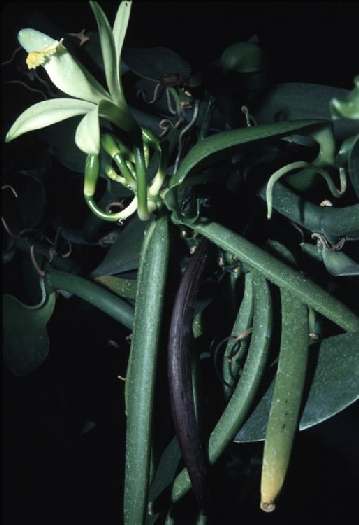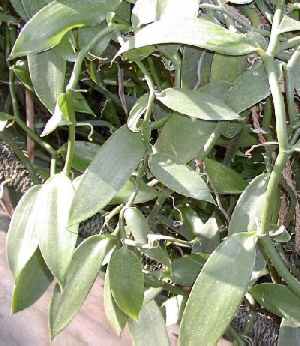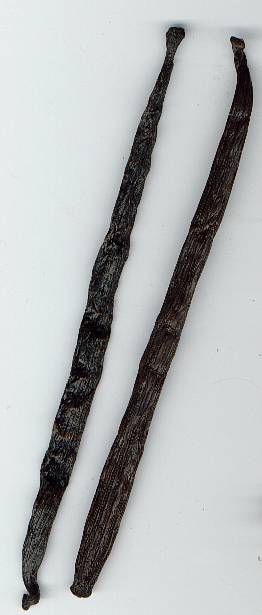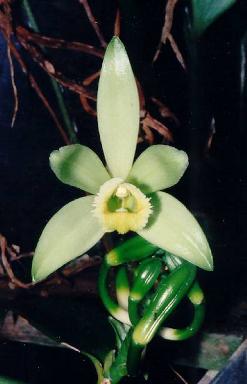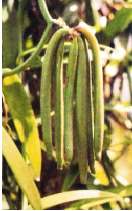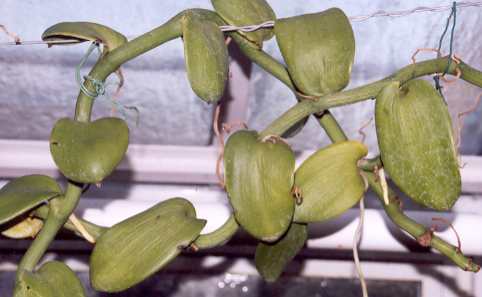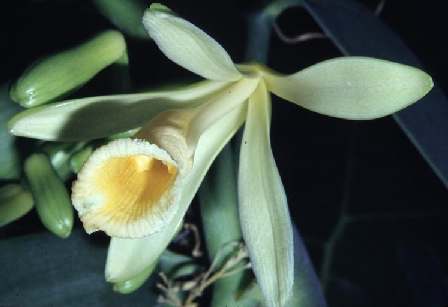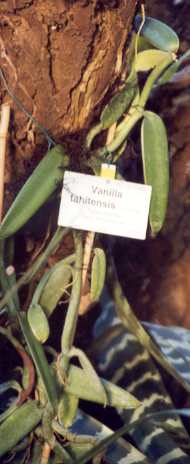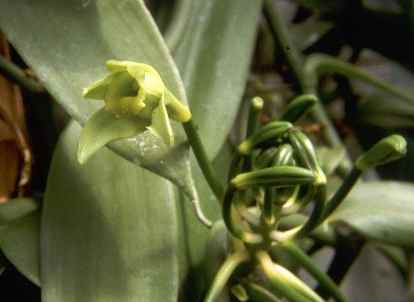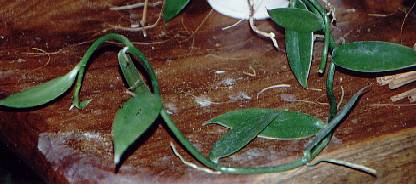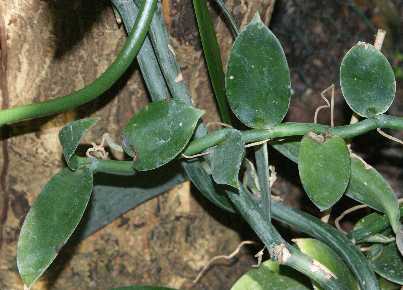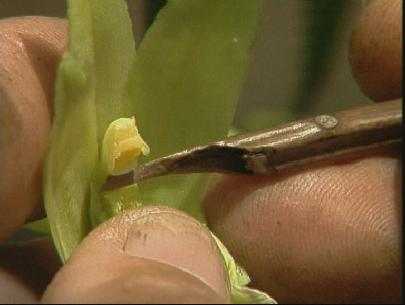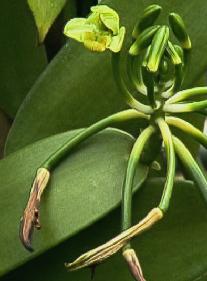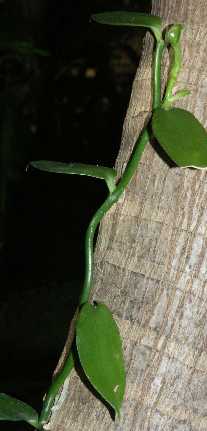Columbian usage. Both the Mayas and, later,
the Aztecs used Vanilla to flavour a special drink prepared
from water, cocoa beans and spices: chacau haa
(or chocol haa) in the Mayan and
cacahuatl in the Aztec tongue (Náhuatl).
Mayan chocolate, as is still drunk in southern México
(Yucatán), Guatemala and Belize, is often spicy,
containing chiles and other native
(allspice,
annatto) or imported
(black pepper,
cinnamon) spices. Sweeteners (sugar
or honey) are possible but in no way mandatory.
The drink is enjoyed hot or cold, but in any case it is whipped
such that it becomes foamy; the foam is considered the most
delicious part.
The Aztecs drank chocolate mostly cold and often used honey
to get a sweet product; in our days, of course, cane sugar is
more common. Aztec chocolate may contain all aromatics mentioned
in the previous paragraph, and more (e. g.,
paprika
or Mexican pepper leaves); for cultic
purposes, the deeply red colour brought by addition of
annatto was highly esteemed.
When Hernán Cortés forced the Aztec ruler Moctezuma
to grant him an audience on November 14th,
1519, he was the first European to try chocolate; less than three years later,
the great Aztec capital Tenochtitlán had been shattered to pieces, and
the Aztec empire had ceased to exist.
Vanilla was first used in Europe mainly for the same purpose as in
America before: To flavour drinking chocolate, a very popular drink
among the 17.th century European nobility. European drinking chocolate
was almost exclusively sweet and might use a lot of additional flavourings,
e. g. anise, cinnamon,
but also exotic animal products like musk and ambergris; the main European
contributions to chocolate was, however, the use of milk instead of
water, which culminated much later, at the end of the 19.th century,
in the production of milk chocolate bars.
Chocolate aside, vanilla is used for a large number of other sweet
dishes in Western cuisine; its usage is salty foods is very uncommon.
Vanilla is essential for a large number of cookie
recipes, for cakes, sweet continental puddings and gruels, and
even for milk-based sweet drinks; moreover, dry pastries (e. g.,
Strudel in Germany, Austria and Czech Republic; see poppy for more)
are sometimes served with hot, vanilla-scented sweet sauces. The
most important, almost proverbial, application is, however, vanilla
ice cream. The largest part of vanilla-flavoured
industrial
products do not contain true vanilla, but the much
cheaper synthetic vanillin, the main (but not single) constituent of
vanilla aroma.
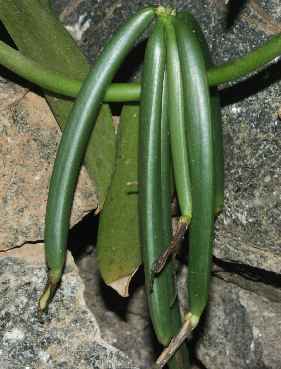
|
|
Ripening vanilla pods
|
Vanillin can be easily produced from wood wastes of the paper industry; the
same chemical reaction, by the way, lies behind the vanilla aroma of some
wines aged in wood barrels (barrique). Pure vanillin does
have a scent reminiscent to vanilla, but it lacks the subtle flavour of the
true spice. It can, therefore, not substitute vanilla in high-quality products.
In no product this is more obvious than in vanilla ice cream, which (apart
from rare exceptions) has disappointing flavour. Vanilla ice cream made with
natural vanilla extract or vanilla beans (you can recognize this by the tiny
black seeds in the ice cream) is comparatively rare, and of course somewhat
more expensive.

|
|
Ripening vanilla pods
|
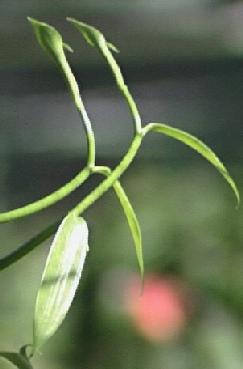
|
|
Vanilla shoots
|
At a first glance, ice cream seems a typical product of industrialized
Western countries, since its production and transport calls for significant
technical facilities. Yet, even Alexander the Great enjoyed iced desserts,
and several Roman emperors are reported to have adopted this custom.
Chinese Emperors of the Tang dynasty had ice-cooled deserts based on
buffalo milk flavoured with camphor to lessen the discomfort of hot
summer days, and similar recipes were later developed by the Indian
Mughal dynasty (kulfi [कुल्फ़ी]). Cooling was achieved by snow
transported to court from distant mountains, which is a considerable logistic
success.
Contemporary ice creams owe their smooth and fluffy texture not
only to various emulgators, but also to tiny gas bubbles trapped in
the semisolid matrix. This feature distinguishes the soft ice of our
days from the half-frozen sherbets of Nero or Jehan Gir.
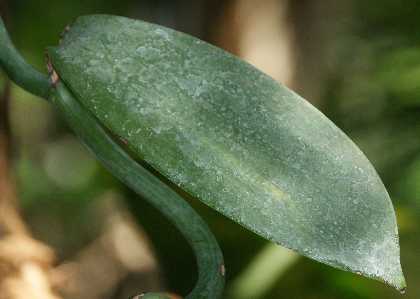
|
|
Vanilla leaf
|
Ice creams are produced in a huge variety of different flavours;
most popular in Western countries are chocolate, fruit flavours
(of the plants mentioned on these pages, lemon,
orange,
pomegranate,
and mango)
peppermint, vanilla,
tonka and a wealth of nuts, e. g., hazelnut,
almond or coconut.
Less main stream, but excellent are ice creams produced from aromatic herbs
(lemon verbena, basil,
lavender) or spices like
cinnamon, cardamom and
nutmeg. In some countries, ice creams with floral
scent are popular, e. g., rose in Iran or
kewra in India; Thailand and Indonesia have ice
from pandan leaves to offer. The
saffron ice cream sold in Indian tourist centers I
found almost addictive (best was saffron–pistachio, for those planning to
spend their vacation in Mount Abu/Rajasthan). There are, however, other
flavours of ice cream described in the literature which I mention without being
able to imagine how they might taste: Reports tell about
garlic and chile ice
creams, a challenge for the stronghearted!
Different to most other spices, the processing of vanilla is rather
complicated, because fresh vanilla pods do not have any taste; the vanillin is
bound as a glycoside and must be set free by enzymatic reaction, normally
induced by a sequence of blanching (Bourbon) or steaming (México)
operations. This, and the need of manual pollination outside México,
makes vanilla one of the most expensive spices.
Vanilla is not frequently combined with other spices, although saffron or cinnamon are
probably worth trying. Tonka beans,
mahlab cherry stones or
pandanus leaf extract make interesting
alternatives for vanilla; another possibility are scented flower distillates
(rose, kewra).
Everything expensive gets adulterated and faked — vanilla is no
exception. First of all, synthetic vanillin is an obvious choice to
spice up
beans of
low quality, or beans that have been extracted to yield the expensive vanilla
extract (won by macerating vanilla pods in a mixture of water and alcohol).
Synthetic vanillin may also appear in the extract itself. Especially in
México, tonka bean extract shows up
regularly in vanilla extract. See also tonka bean
for vanilla-flavoured cigarettes.
Two related vanilla species
(V. pompona, also called Guadeloupe vanilla or Antilles
vanilla from the West Indies and V. tahitensis from Tahiti),
yield vanilla beans with a significantly deviating flavour.
Up to the recent past, both species were considered inferior
to V. planifolia, and they were sometimes abused to adulterate
vanilla products. Of course, unusualness
is not necessarily a sign of low value, and the two exotic vanillas
might be used in their own right.
In the first decade of the 21. century, Tahiti vanilla experienced a sudden rise in
popularity and application range, particularly in Western gastronomy. Many of the more
expensive restaurants now prepare traditional vanilla desserts with Tahiti vanilla,
e. g., panna cotta, crème brûlée or
simply vanilla ice cream. There is a curious parallel in the increasing use
of tonka beans, which are often employed in the same
etablissements for the same purposes.



